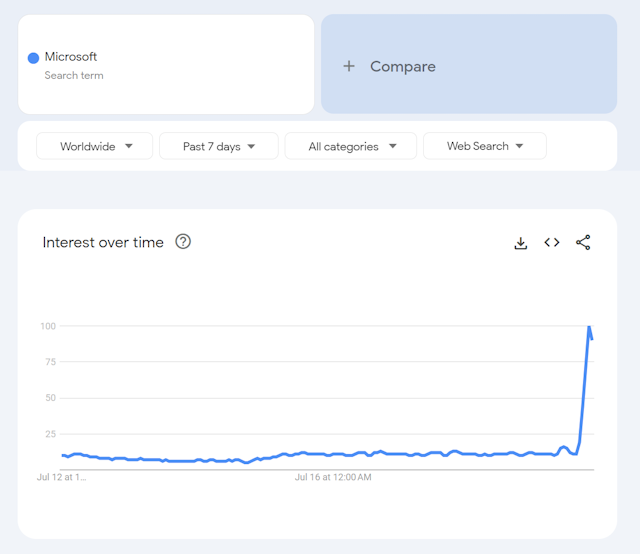When IT hits the fan: How brands are responding to the world’s biggest outage ever
On Friday, July 19, the world woke up to what is being dubbed the biggest IT outage ever. The Drum explores how brands navigated a tumultuous, complicated comms issue at a time when essential services were denied to users.

How should brands respond to the global IT outage
A glitch in an update pushed out by cybersecurity firm CrowdStrike on Friday catalyzed a global outage on Microsoft systems. As a result, air travel came to a grinding halt, TV broadcasts hit the static and major retailers failed to process payments. There are reports of some emergency services and even the stock exchange losing the ability to function.
Unfortunately for Microsoft, only its machines have been impacted by CrowdStrike’s malfunctioning update, attracting unfair backlash to the tech giant.
CrowdStrike, whose very purpose is to protect businesses from IT outages, has had a fifth of its value wiped in mere hours.
This is a crisis comms story to end all crisis comms stories. Due to the complexity of the issue, confusion abounded, with both the news media and consumers on social media asking the big question: Who was to blame?
Then there are the innocent organizations caught up in the fiasco – businesses both big and small, from airports and banks to medical services and retailers.
With the reputation of hundreds of global brands potentially at stake, what should they do?
Explore frequently asked questions
The buck stops with CrowdStrike
First and foremost, this is a crisis of the “most serious magnitude” for CrowdStrike, says Jonathan Hemus, managing director and crisis management consultant at Insignia Crisis. “To be the cause of one of the biggest outages ever seen, is going to present a massive reputational and trust threat for CrowdStrike – it’s potentially an existential threat.”
To survive the tumult, CrowdStrike will not only need a perfect response through the immediate crisis, but also months of reputational damage control.
“This will be the acid test of its management team,” Hemus says. So far, he hasn’t been impressed by what he has seen – he says that a statement released by CrowdStrike CEO George Kurtz misses the mark.
CrowdStrike is actively working with customers impacted by a defect found in a single content update for Windows hosts. Mac and Linux hosts are not impacted. This is not a security incident or cyberattack. The issue has been identified, isolated and a fix has been deployed. We…
— George Kurtz (@George_Kurtz) July 19, 2024
“Nowhere within it, does it express any care, concern, regret, empathy with the people who are affected by it,” Hemus says. In crisis comms, he suggests, the perfect formula is: “empathy, understanding, reassurance and then communication of the actions that you are taking.”

Advertisement
Microsoft, for its part, has an “interesting challenge” ahead, he says. The tech firm isn’t responsible, but because it was solely impacted, it’s been the brunt of much of the blame. The spike in searches for Microsoft is telling.
“It needs to tread a very careful path of not washing their hands of this incidence, but at the same time, making it very clear that it is not the cause of this,” Hemus says.
The company has issued press statements explaining that it is a third-party software issue. “We’re aware of an issue affecting Windows devices due to an update from a third-party software platform. We anticipate a resolution is forthcoming,“ a Microsoft spokesperson says. Interestingly, it hasn’t posted on its social channels.
How should brands impacted by the outage respond?
Crisis experts will direct impacted brands to swiftly acknowledge what has happened, tell customers what actions they are taking – and apologize, even though it’s not their fault.
Hemus praised Ladbrokes for its approach and “down-to-earth tone.“ The UK betting company wrote on X: “You might have seen the news about the global technical issue affecting airlines, banks etc. Unfortunately we’re experiencing this too. We’re working hard to resolve the issue but don’t know when it will be fixed. Thanks for being so patient and apologies for the inconvenience.”
The typically jovial Ryanair X page has taken a very different tone this morning, using its channels to tell travelers it has been impacted and advise them on what to do. Hemus says that Ryanair would be “ill advised” to be jokey or post memes at a moment like this. “In a crisis, a brand should be the starting point should be that the brand talks with its normal tone of voice but adjusted for the gravity of the situation,” he says.
And most brands have indeed taken a serious tone of voice. The Drum trawled X to find any examples of humor. A post from a local Australian news station 10 News, reimagining its logo as a doddle was one example.
#BREAKING: Widespread Microsoft outages have sent IT systems across Australia into a tailspin this afternoon, with banks, airlines, police, and other systems reported as being affected.
(And humble news social team admins too, evidently. We're doing our best here. More to come.) pic.twitter.com/IM0LZARu5v
— 10 News First (@10NewsFirst) July 19, 2024
However, Tamara Littleton, executive chair of Social Element and co-founder of Polpeo, encourages brands to be a “little more human” and less “robotic”.
As she puts it: “We’re seeing a lot of ‘a global outage is affecting our systems… we’re working hard to resolve the issue’ type statements, which don’t really add any value to customers. Companies should put themselves in their customers’ shoes – what do they care about?”
Unfortunately, due to a global Microsoft Servers outage which is affecting many systems, including ours, this morning’s ticket release will be postponed until midday.
The website will also remain unavailable until the issue is resolved. Further updates will be provided here,…
— Manchester United Matchday (@ManUtdMatchday) July 19, 2024
She gives the example of Manchester United’s match day statement. The first half of the statement starts well, she says, providing a precise time for ticket release. But the second half of the statement is “too vague ... and sounds robotic.”
It would have been better, in her view, to say: “Because this is a Microsoft global issue, we don’t know when the website will be back up and running, but we’ll let you know as soon as we do, and we’ll give you hourly updates. We know how many of you were looking forward to buying tickets, and we’re so sorry this has messed up your day,” or something along those lines. The key, she says, is to express empathy and connect on a human level.
Advertisement
Suggested newsletters for you
Some further practical advice came from the global full-service agency IMA’s social activation account director, Lizi Legge, who tells brands to use relevant hashtags to let people know that it’s not just them impacted.
“Misery loves company, and seeing that lots of people are struggling with the same issue can both soften the blow and build trust that you’re not just passing the blame,” she says. Currently, the hashtags #Microsoft, #CrowdStrike and #BSOD (blue screen of death) are all among X’s trending topics.
Once the problem has been fixed, Legge says brands should follow up with customers and, where it’s relevant, offer a discount or a compensation gesture.
This is not a flash in the pan story. CrowdStrike and Microsoft have months of crisis management work to do. For brands caught up in the fiasco, there will be weeks of customer service and IT problems to deal with outside of the challenge of remedying any reputational fallout.
